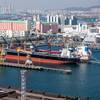Kalmar Helps Port of Long Beach to Meet Green Objectives
Kalmar's new all-electric terminal tractor is helping the Port of Long Beach (POLB) meet its eco-efficiency objectives while satisfying the commercial demands of the users of the second-busiest container seaport in the US.
According to a press release from Kalmar, a part of Cargotec Corporation, POLB in California handles trade worth in excess of $180bn from 175 shipping lines connecting to 217 seaports around the world. In 2017, more than 7.5 million container units passed through the port.
US port operators are increasingly demanding more environmentally friendly machines and Californian ports have taken a lead in this respect by setting a target of having fully electric fleets by 2030.
Ports present some unique environmental challenges given their frequent proximity to residential areas. Diesel emissions are a major concern - especially when transiting to and from the port to inland drayage concentrations, warehouses and other facilities – and the potential inclusion of external warehousing under the port’s emissions output has highlighted the issue of ‘incidental emissions’.
Kalmar has been working with port authorities to improve air quality in the Long Beach area for more than a decade. As long ago as 2006, the company was involved in a project to develop, build and test ultra-low emissions hybrid cargo handling vehicles.
Now the Kalmar Ottawa electric terminal tractor, T2E, is playing a key role in a freight/drayage electrification project that will test 25 zero- or near zero-emission vehicles over a 12 month period. The Port of Long Beach freight electrification project, funded mostly by a $9.7m grant from the California Energy Commission, will be the nation’s largest project for zero emissions cranes and other seaport cargo handling equipment.
The project includes converting nine diesel-electric rubber tyre gantry cranes into fully electric equipment at one terminal, purchasing 12 battery-electric yard tractors for two more terminals, and the conversion of four liquefied natural gas or LNG trucks into plug-in hybrid-electric trucks for a drayage trucking firm.









